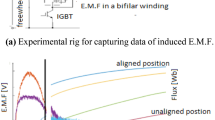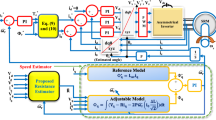Abstract
Switched reluctance motors (SRMs) require sensitive rotor information in order to work sensitively and properly and especially for the commutation of phase currents. Position information is generally acquired from a sensor which is generally placed into the stator or connected to the rotor. However, sensors have disadvantages in terms of cost, safety, complexity and volume. In order to remove these disadvantages, recent studies concentrate on SRMs working without a position sensor. In this study control methods working without a position sensor are examined, the applied method is presented comprehensively. The education and test data of the artificial neural network is not obtained from simulation or experimental results; it is obtained from magnetic analyses carried out in ANSYS 10 and the results are used in position speed and current sensorless control of SRM. The validity of proposed method is demonstrated by using DS 1103.















Similar content being viewed by others
References
Aydın Ç (2001) Bir Anahtarlamalı Relüktans Motorun Hibrit Gözlemci ile Pozisyon Algılayıcısız Çalıştırılması, Doktora Tezi, Gazi Üniversitesi Fen Bilimleri Enstitüsü, Ankara
Haris WD, Lang JH (1990) A simple motion estimator for variable-reluctance motors. IEEE Trans Ind Appl 26(2):237–243
Panda SK, Amaratunga GAJ (1993) Waveform detection technique for indirect rotor-position sensing of switched-reluctance motor drives. II. Expermental result. IEEE Electr Power Appl 140(1):89–96
Panda D, Ramanarayanan V (2000) Sensorless control of switched reluctance motor drive with self-measured flux-linkage characteristics. In: IEEE power electronics specialist conference, vol 3, pp 1569–1574
Mvungi NH, Lahoud MA (1991) A new sensorless position detector for SR drives. In: IEEE power electronics and variable-speed drives, pp 249–252
Brosse A, Henneberger G, Schniedermeyer M, Lorenz RD, Nagel N (1998) Sensorless control of a SRM at low speeds and standstill based on signal power evaluation. In: IEEE IECON’98, vol 3, pp 1538–1543
Bass JT, Ehsani M, Miller Timothy J E (1986) Robust torque control of switched-reluctance motors without a shaft-position sensor. IEEE Trans Ind Electron IE–33:212–216
Ehsani M, Husain I (1992) Rotor position sensing in switched reluctance motor drives by measuring mutually induced voltages. In: Industry Applications Society annual meeting, vol 1, pp 422–429
Direnzo MT, Khan W (1997) Self-trained commutation algorithm for an SR motor drive system without position sensing. In: IEEE industry applications conference, vol 1, pp 341–348
Gallegos-Lopez G, Kjaer PC, Miller TJE (1999) High-grade position estimation for SRM drives using flux linkage/current correction model. IEEE Trans Ind Appl 35:859–869
Ma Bin-Yen, Feng Wu-Shiung, Liu Tian-Hua, Chen Ching-Guo (1998) Design and implementation of a sensorless switched reluctance drive system. IEEE Trans Aerosp Electron Syst 34:1193–1207
Gallegos-Lopez G, Kjaer PC, Miller TJE (1998) A new sensorless method for switched reluctance motor drives. IEEE Trans Ind Appl 34:832–840
Ertugrul N, Cheok AD (2000) Indirect angle estimation in switched reluctance motor drive using fuzzy logic based motor model. IEEE Trans Power Electron 15:1029–1044
Cheok AD, Zhongfang W (2005) Fuzzy logic rotor position estimation based switched reluctance motor DSP drive with accuracy enhancement. IEEE Trans Power Electron 20:908–921
Kosaka T, Ochial K, Matsui N (2001) Sensorless control of SRM using magnetizing curves. Electr Eng Jpn 135(2):60–68
Brosse A, Henneberger G (1998) Different models of the SRM in state space format for the sensorless control using a Kalman fitler. In: IEEE power electronics and variable speed drives, pp 269–274
Falahi M, Salmasi FR, Lucas C (2006) Modified passivity-based control of switched-reluctance motor with speed and load torque observers. In: IEEE industrial electronics, IECON 2006, pp 1077–1081
Ünal S (2009) Sürekli Mıknatıslı Senkron Motorlarda Yapay Sinir Ağları Kullanarak Algılayıcısız Konum Tahmini, Doktora Tezi, Fırat Üniversitesi Fen Bilimleri Enstitüsü, Elazığ
Hudson CA, Lobo NS, Krishnan R (2008) Sensorless control of single switch-based switched reluctance motor drive using neural network. IEEE Trans Ind Electron 55:321–329
Mese E, Torrey DA (1997) Sensorless position estimation for variable reluctance machines using artifical neural networks. In: Proceedings of IEEE IAS annual meeting, pp 540–547
Mese E, Torrey DA (2002) An approach for sensorless position estimation for switched reluctance motors using artifical neural networks. IEEE Trans Power Electron 17:66–75
Reay DS, Williams BW (1999) Sensorless position detection using neural networks for the control of switched reluctance motors. In: IEEE international conference on control applications, vol 2, pp 1073–1077
Bellini A, Filippetti F, Franceschini G, Tassoni C, Vas P (1998) Position sensorless control of a SRM drive using ANN-techniques. In: IEEE industry applications conference, vol 1, pp 709–714
Polat M, Kürüm H (2011) Analytic design of dimensional at submersible pump-type Switched Reluctance Motor with 8/6 poles. e-Journal New World Sci Acad 6(1):359–378
Author information
Authors and Affiliations
Corresponding author
Appendix
Appendix
The size of the motor is given following [24]:
- The number of stator/rotor poles:
-
:8/6
- The stator/rotor pole arc length:
-
:\(22^{\circ }/24^{\circ }\)
- The stator/rotor pole width:
-
:9.98/10.9 mm
- The stator/rotor pole step:
-
:\(45^{\circ }/60^{\circ }\)
- The stator outer diameter:
-
:92.2 mm
- The stator inner diameter:
-
:52 mm
- The length of the stator package:
-
:180 mm
- The shaft diameter:
-
:22 mm
- The rotor outer diameter:
-
:51 mm
- The length of the stator pole:
-
:10.1 mm
- The length of the rotor pole:
-
:7.9 mm
- The size of air gap:
-
:0.5 mm
Rights and permissions
About this article
Cite this article
Polat, M., Oksuztepe, E. & Kurum, H. Switched reluctance motor control without position sensor by using data obtained from finite element method in artificial neural network. Electr Eng 98, 43–54 (2016). https://doi.org/10.1007/s00202-015-0338-1
Received:
Accepted:
Published:
Issue Date:
DOI: https://doi.org/10.1007/s00202-015-0338-1




